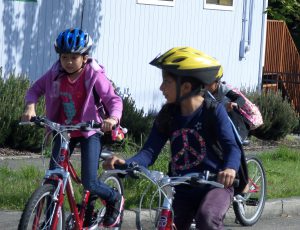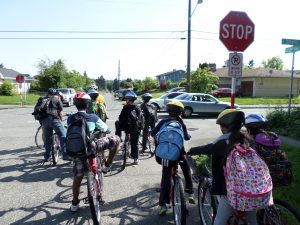
The path to healthier living for children could be the same one they take to school.
Children who participated in adult-supervised group bicycle rides to and from school increased their moderate-to-vigorous physical activity by 21 minutes per day and daily cycling commutes by 45%, according to a pilot study recently published in the American Journal of Preventive Medicine.
The additional exercise study participants gained from riding in the groups, known as bike trains, accounted for 35% of the 60 minutes of physical activity recommended daily for children.
“Regular physical activity can help build muscle and bone strength, raise energy levels, and help reduce the risk of conditions like obesity and heart disease,” said Seattle Children’s researcher Dr. Jason Mendoza, who served as the principal investigator for the study.
Mendoza has also led and collaborated on research studying walking school buses, where adults supervise groups of children as they walk to and from school.
“Several studies have looked at the health benefits of walking to and from school. This is the first study that examines a bike train program,” Mendoza said.
Finding the time for physical activity
As rates of childhood obesity have skyrocketed across the country, most children need to look outside of a school setting to find rich sources of exercise.
Only 3.6% of public and private elementary schools require daily physical education for all students, according to Healthy People 2020, a health-focused initiative from the United States Department of Health and Human Services. Less than 60% of elementary schools require daily recess periods.
“Overall, schools are placing more emphasis on classroom instruction and less on physical education classes and recess periods than they used to,” Mendoza said. “Kids need time to exercise their bodies as well as their minds and release their physical energy in a healthy way.”
Other research has shown that early morning exercise positively impacts children’s academic performance, behavior and attitude.
Pedaling into the past to address an issue in the present
A drastic shift from active commuting to school by walking or biking to passive commuting, like riding in a car or bus, has coincided with rates of childhood obesity tripling over the last four decades. Nearly half of all children in the U.S. were active commuters in 1969. Forty years later, less than 13% of children actively commuted to school. Currently, only 1% bike to school.
“Previous research suggests losing sources of exercise like biking to school could be a contributing factor to drops in physical activity and increased rates of obesity in children,” Mendoza said.
Mendoza and his colleagues hypothesized that introducing a bike train program would increase rates of cycling to and from school and hopefully encourage long-term adoption of cycling as a means of transportation—eventually leading to increased physical activity.
Putting the bicycle train program into action

For the study, 54 fourth- and fifth-grade students from four inner-city Seattle schools that enroll lower-income families were equipped with bicycles, bike helmets and other safety gear.
“Lower-income children from diverse backgrounds are often left out of this type of research and have among the lowest rates of physical activity and highest rates of obesity,” Mendoza said.
Most participants lived less than 2 two miles from their school and all could keep the bikes and equipment following their voluntary participation in the study.
Bike Works donated and helped maintain the bikes. Cascade Bicycle Club provided a 2- to 3-hour safety course for all of the children prior to participation. The program also followed National Center for Safe Routes to School (SRTS) bike train guidelines.
Two of the schools were randomly chosen to receive the bike trains, and Seattle Children’s staff members rode with participants to and from school for the duration of the study. The bike trains arrived 25 to 30 minutes before school started so riders could participate in school breakfast programs.
“I had a good time and I was able to get a lot of exercise,” said Jann Isabel Adajar, who participated in the study as a fifth-grader. “It was helpful to have the instructors there to encourage us when it became hard to ride up some of the hills.”
Adajar, who now lives too far from her current school to bike, still has her bike three years after the study began and uses it after school, when time permits.
The next step in bike train research is to recruit for larger and longer-term studies that involve parents, community members, school staff and other responsible adults.
Starting a Bike Train
There are several resources for those who wish to start a bike train in their community. The SRTS bike train planning guide focuses on planning a route and ride schedule; safely equipping and preparing riders and leaders; and extensive safety checklists applicable to bike riders of all ages.
The Pedestrian and Bicycle Information Center provides links to cycling resources in every state, including state-specific cycling laws, cycling plans, and contact information for state bicycle and pedestrian coordinators.
“Engaging daily in a fun, safe activity such as biking, is an important way we can increase physical activity to ensure optimal child development and health,” Mendoza said. “There is a long way to go, but we will continue to research and help children, families and schools, especially those who are socioeconomically disadvantaged, to tap into and re-discover ways to live the healthiest life possible.”
Resources:
- Bicycling to School Together – Safe Routes to School
- Pedestrian and Bicycle Information Center
- Bicycle Trains, Cycling, and Physical Activity: A Pilot Cluster RCT – American Journal of Preventive Medicine
- Healthy People 2020
- Seattle Children’s Research Institute’s Faces of Research

